This Autonomous Drone Stock Is Still Flying Under the Radar
Editorial Feature | Oct 18, 2021 | Tech
Designed with the direct input of law enforcement, military, rescue services and oil and gas exploration Plymouth Rock Technologies (CSE:PRT | OTC:PLRTF)(CSE:PRT | OTC:PLRTF) has first-mover advantage in a $129 billion market.
A young company has aimed its technological superiority at next generation unmanned technologies, threat detection and screening. Their focus is on security, environmental monitoring , exploration and utilizing their technologies as a critical tool, from fighting wildfires to wars.
Security and defense industries across the globe have taken notice.
So has U.S. News and World Report. In September 2021, it named Plymouth Rock Technologies as one of the “7 Drone Stocks to Watch as the Technology Soars.”1
Investors have zeroed in on the company, too. Its shares are up 53% since early August.2
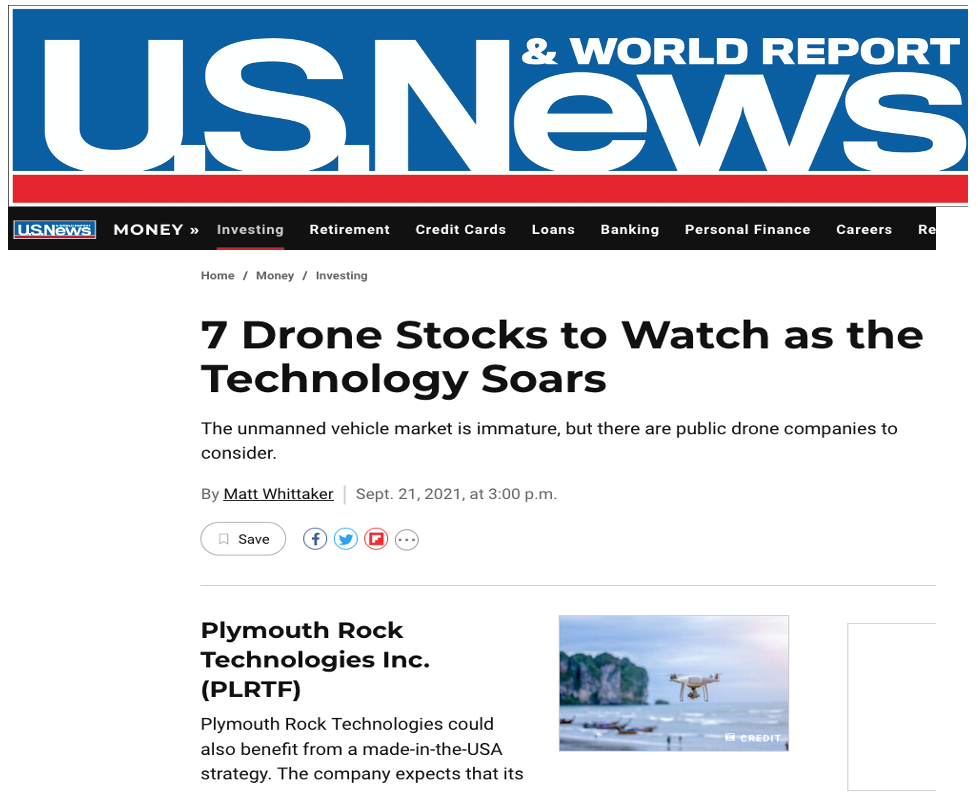 And, in an additional sign of strength and liquidity, a slew of new investors are discovering Plymouth Rock Technologies Inc. (CSE:PRT | OTC:PLRTF)(CSE:PRT | OTC:PLRTF), as by mid-October, its daily volume had quadrupled to 1 million shares or more.
And, in an additional sign of strength and liquidity, a slew of new investors are discovering Plymouth Rock Technologies Inc. (CSE:PRT | OTC:PLRTF)(CSE:PRT | OTC:PLRTF), as by mid-October, its daily volume had quadrupled to 1 million shares or more.
This heightened interest in Plymouth Rock should come as no surprise.
In fact, it’s very easy to see why this company’s innovative technologies are capturing investors’ imaginations, as well as the attention of military and emergency service agencies, both in the U.S. and abroad.
Global Threat Detection Market Tops $70 Billion Dollars
Rising global unrest is creating a robust market for technologically advanced threat detection systems, specifically those which are capable of detecting weaponry, explosives, radiological and nuclear devices, as well as chemical and biological agents.
Growing at a rapid pace of 12.8% CAGR, the industry is expected to reach $163.4 billion by 2025.
While the developing economies of the Asia Pacific region are prompting a portion of that growth, the U.S. looks to be the main driver of this technological shift. The Department of Homeland Security (DHS) alone allocated $51.7 billion in threat detection spending last year, an increase of $4.2 billion over the year prior.3
Despite the company’s age, the executives and scientists that make up Plymouth Rock’s personnel have worked together since the late 1990s to develop state-of-the-art technologies in threat detection to meet this market demand, with over 100 years of combined experience.
Their breakthrough products include an ultra-compact radar device for mobile weapons detection, and a series of environmentally ruggedized drones capable of serving military and emergency response duties, explosives detection and wildfire response and management.
And it’s beginning to pay off… the company’s early products are moving into the real-world right now, in some of the most complicated environments and conditions.
Advanced Thermal Imaging Technology A Key Wildfire-Fighting Tool
Wildfires persist as one of the most common and destructive natural disasters humankind faces today.
Since 1983, the National Interagency Fire Center has documented an average of approximately 70,000 wildfires per year in the United States alone.4
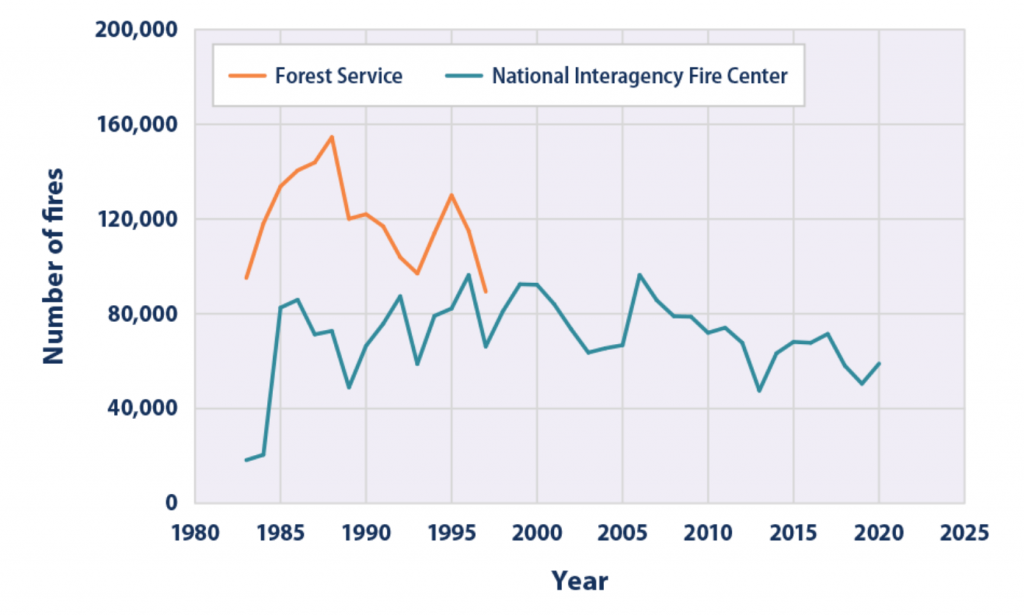
In 2020, 58,950 wildfires burned a staggering 10.1 million acres, the second-most acreage impacted in a year since 1960. Nearly 40% of that total is accounted for in the heavily inhabited state of California.5
Globally, the statistics tell an even darker story.
Throughout 2020, Brazil reported approximately 223 thousand wildfire outbreaks, by far the highest figure in South America. Argentina registered the second largest number of wildfires in the region that year, at over 74 thousand.6
The big problem: Most wildfires spread too quickly to control, such as the tragic 2018 Camp Fire in California that completely destroyed the towns Paradise and Concow in around four hours.
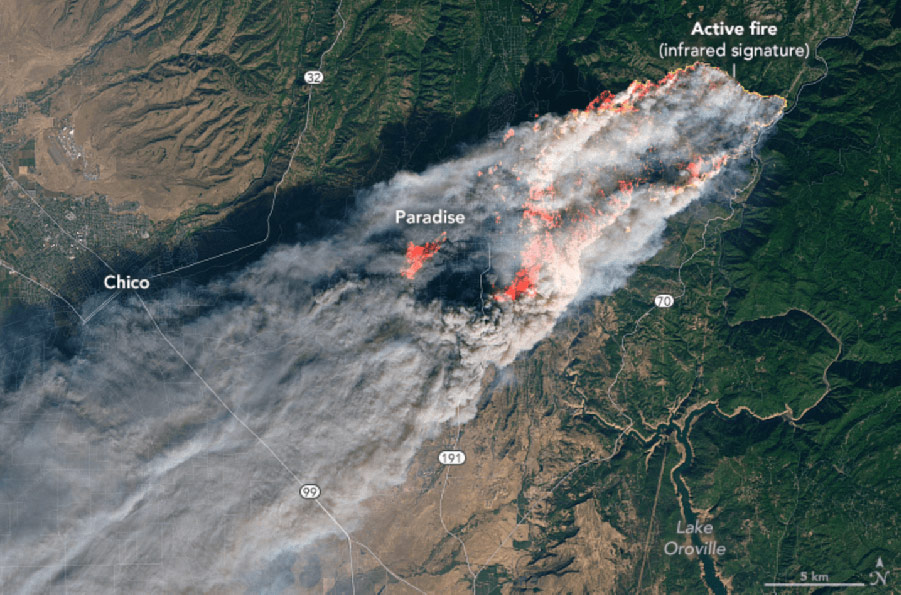
Satellite view from space of Paradise, California, courtesy of NASA Earth Observatory
Like many wildfires, this one began in a remote location and was pushed into the towns by a steady east wind, obliterating one community after the next. Ultimately the fire displaced close to 50,000 people and destroyed more than 11,000 homes.7
Aside from these obvious perils, a wildfire at this scale produces choking smoke that degrades air quality to hazardous levels for tens of millions.
And while profound advancements have transformed all areas of life and industry, the tools used by firefighting agencies have remained hopelessly inferior.
Local fire departments have typically used consumer drones once a fire is discovered – those drones can only deliver basic imagery in a very small area, and can only be flown far away from the most affected zones, as a pilot needs to remain close by to control the aircraft.
First To Market With A True 21st Century Solution
That is, until Plymouth Rock Technologies Inc. (CSE:PRT | OTC:PLRTF)(CSE:PRT | OTC:PLRTF) brought to market an ingenious technology: The X1-H drone.
Should it purely focus on X1-H? Not the X1 range with hybrid option, 4+ hours…
The X1 drone can do what manned helicopters and tanker planes can’t, they can fly deep into heavy smoke day or night, carrying fire retardants, as well as giving real time aerial guidance to firefighters on the ground to hotspots before they erupt.
Using state-of-the-art co-axial heavy lift motors, and flight control intelligence the X1 is years ahead of traditional drone designs. The unique co-axial framework, combined with a 40% increase in motor torque, deliver a propulsion platform that is unequalled in safety, power, performance, and carrying capacity.
Along with its advanced flight characteristics, the combined sensor capabilities of the X1 offer real time situational awareness, a critical advantage when it comes to identifying fire-susceptible zones.
The X1’s AI-driven software suite delivers multiple intelligence streams and aerial data to operators, such as wind speed, multi-spectral infrared details and firefighter location.
This crucial information grants fire and rescue crews the first time ever ability to map out and identify large-scale fire distribution and levels of intensity. That means they know exactly where to extinguish the worst of a fire, as well as how to safely reallocate resources to new hotspots.
Preparing To Launch 100% American-Made Drones to Australia’s Public Safety Department
And now, Plymouth Rock Technologies Inc. (CSE:PRT | OTC:PLRTF)(CSE:PRT | OTC:PLRTF) breakthrough X1-H drones are set to earn their stripes on the frontlines of the Australian fire season.
There could be, in fact, no greater compliment for a drone maker than an agreement to deliver its drones and technology to what can be at times one of the world’s harshest environments.
Investors likely remember the 2019-2020 Australian bush fire season.
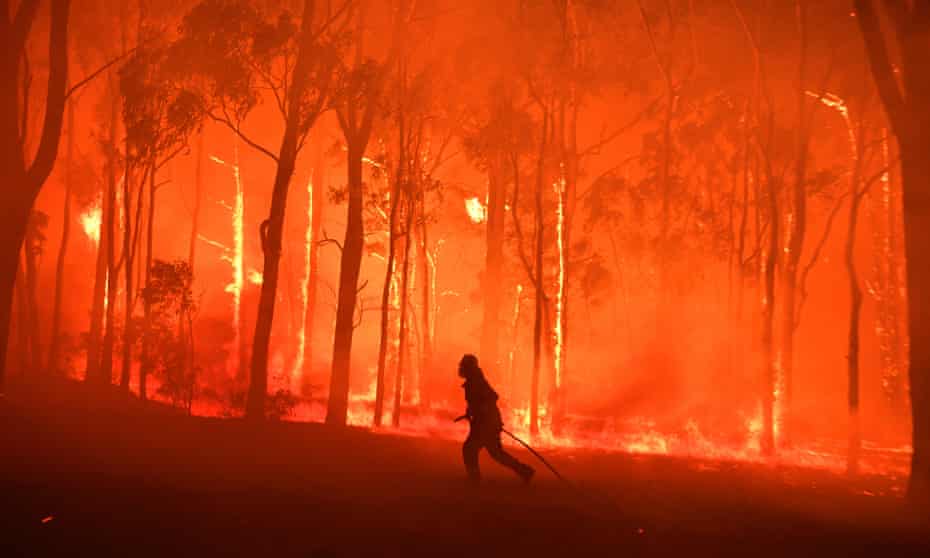
Firefighters tackle the Gospers Mountain fire outside Sydney. Courtesy of theguardiuan.com
The fire roared through 65.6 thousand square miles,8,9 an area more vast than the state of Georgia10. It killed more than 1 billion animals, its plume flew 22-miles high, and traveled 41,000 miles, a distance almost two times around the earth.11
It was this unfathomable destruction that drew Australian defense and security contractor, SDS Group Australia, to Plymouth Rock Technologies Inc. (CSE:PRT | OTC:PLRTF)(CSE:PRT | OTC:PLRTF).
Had Plymouth Rock drones been on the scene their surveillance data and HD video feeds could have sent firefighters to the fire’s vortex or hottest spots. The system’s AI would have measured atmospheric conditions, and changes in wind direction, too.
After consulting with Australian government officials, the contractor signaled an agreement with Plymouth Rock to partner in early detection of remote wildfires.
“Buying a purpose-built drone is significantly better when performing tasks involving national security and risks. There are many low-cost drones available from various manufacturers across the globe, but not all can be trusted when it comes to intelligent and national security services.
“Trustworthy drone manufacturers are critically needed, and Plymouth Rock Technologies with over a century of cumulative experience, understands security screening and threat detection better than most players in the market.” – Enterprise Security, 2021
New U.S. Federal Law Commits $100 Million To Solving the Wildfire Problem12
Of course, Australia is not alone in the seeing the potential role AI-powered drones can play in the future of wildfire fighting.
After a brutal 2020 season in which 46,000 wildfires nationwide burned nearly 6 million acres, a U.S. federal law was penned that should expedite the rapid nationwide expansion of firefighting drones.13

The Wildfire Management Technology Act, which President Trump signed into law during his final year in office, makes very specific demands.14
Most importantly to investors, the law targets the exact problem that Plymouth Rock is dedicated to solving.
It requires firefighting agencies to outfit crews with GPS locators and to deploy drones to scout and map blazes. The goal is to ensure that wildfires will be mapped in real-time using a network of drones carrying infrared sensors.15
It’s as if the new law was written with but one company in mind – Plymouth Rock Technologies Inc. (CSE:PRT | OTC:PLRTF)(CSE:PRT | OTC:PLRTF).
As you can imagine, the benefit to Plymouth Rock could be off the charts.
X1 broke a Guinness World Record
But there are other types of hotspots across the globe beyond wildfires and brush fires.
There are hotspots created by human unrest, protests, and humanitarian crises.
Among the many deals Plymouth Rock has inked, one stands out above the rest as a true example of the company’s technological superiority over even its biggest competitors.
In a show of true aeronautic advancement, their X1 drone unknowingly broke a world record on its first mission flight while assisting a United Nations mission amid the recent humanitarian crisis in Somalia.
Plymouth Rock broke the existing “beyond visual line of sight (BVLOS)” drone delivery record when it completed an agricultural load mission, completing a 28 mile round trip in 30 minutes… all guided by the drone’s AI, with no human pilot.16
In so doing, they demonstrated the drone’s imperviousness to extreme environmental conditions in a real-world scenario. The X1’s mission was a resounding success despite having to contend with a 21 mile an hour head wind on its outbound leg.
Mind you, the ability to withstand inclement weather has long acted as a barrier to the deployment of drone technologies en masse.
Helping Bring Order To Global Chaos
While the trend in America is to look inward, savvy investors know there’s a ton of profit to be made for American companies that understand the global marketplace.
Plymouth Rock Technologies Inc. (CSE:PRT | OTC:PLRTF)(CSE:PRT | OTC:PLRTF) is such a company.
Just think of the danger and unrest that happened outside of Hamid Karzai airport in late August as U.S. forces left Afghanistan.
A lack of actionable ‘boots-on-the-ground’ intelligence, worsened by a disorganized and hasty withdrawal, ultimately led to a terrorist attack that killed 170 people, including 13 U.S. service members17.
Plymouth Rock Technologies Inc. (CSE:PRT | OTC:PLRTF)(CSE:PRT | OTC:PLRTF) has a new high-tech device that might help prevent future attacks of a similar nature.
Their U.S. government-tested weapon detection system is called CODA, which is short for Cognitive Object Detection Apparatus.
It’s specifically configured to identify concealed threats, such as explosives, assault weaponry, and large bladed weapons.
When mounted on an X1 drone, CODA could really shine in what are known as unstructured crowds. That’s another term for concerts, festivals, and sporting events, as well as riots, demonstrations, and protests.
And the CODA unit is also small enough to be used for mobile operations on the ground. Setup and tear down are swift, making it an ideal security measure for situations with short-term security concerns.
Or it could be used by the military for checkpoints to screen personnel coming into a forward operating base.
The potential for highly adaptable technologies like this is massive, with beneficial applications covering many industries and needs.
And it’s this wide-reaching potential that has drawn the interest of three-letter agencies in the U.S. and abroad.
As of right now, CODA has already cleared rigorous testing hurdles by:

To us, that could hint of potential sales across an unlimited global marketplace.
PRT at the edge of drone policy
Transporting medical goods until recent times has been limited to wheeled motor vehicles and manned aircraft.
Taking into consideration the floods and post hurricane disasters, The FAA and the UK CAA is drafting new rules and PRT is leading the way.
Investors have a rare chance to get into this sector before the rules are published. While we agree the opportunity could still be ripe after the rules go into effect, aggressive investors should view this a generational play.
And it’s at a time when the medical supply delivery market is set to get huge. A recent report from ‘Research and Markets’ projected that the global medical supply delivery service market size is expected to reach $96.6 billion by 2027… that’s 1/10 of a $1 trillion market.21
The report also noted increasing need for “ambulance drones.”
But drone delivery is anticipated to be the fastest-growing segment, owing to the rising adoption of drones to transport blood and blood components during emergencies and disease outbreaks.”22
Odds are the FAA will soon approve the use of drones to deliver medical products, devices, blood, and pharmaceuticals, to hospitals, mass casualty scenes, and offshore vessels in times of critical demand.
A demand that Plymouth Rock Technologies Inc. (CSE:PRT | OTC:PLRTF)(CSE:PRT | OTC:PLRTF) is ready to meet.
You see, their drones are designed with the critically important capability to deliver a wide range of highly sensitive medical equipment.
Upping The Ante So Its Drones Can Deliver Medical Supplies
Recognizing this growing need, Plymouth Rock has developed an insulated storage module that can be attached to its drones.
Called the MediMod, it can deliver both refrigerated and non-refrigerated drugs.
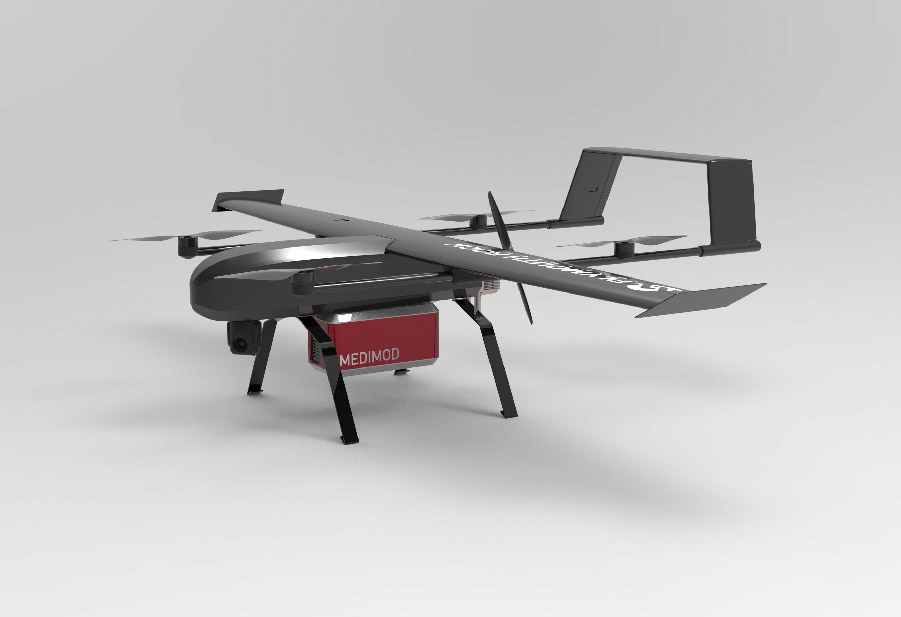
In development prior to COVID-19, the MediMod will have multiple medical uses and advantages, including assisting with the immediate need for rapid deployment of medicines and vaccines to remote sites.
Thanks to an integrated active cooling system the MediMod is set up to transport 1,200 vaccine doses via the X1, and 6,000 by the company’s new fixed-wing vertical takeoff drone – the XV.
The module can also be set to warm in order to transport blood and human transplant organs across cities and to remote destinations. This is the sector in which to be a leader because – and we can’t stress this enough – it’s a domestic market in the U.S. quite literally waiting to launch.
The whole sector is up for grabs because the Federal Aviation Administration (FAA) has yet to approve it.
First To Market In The Medical Delivery Drone Race
Already ahead of the curve, Plymouth Rock is currently testing the parameters of its medical drone delivery capabilities in the United Kingdom.
The company is using its X1 Platform in a series of airborne tests involving delivering emergency apparatuses for the UK National Health Service (NHS).

The tests cover several scenarios that if successful will lead to on-scene delivery of defibrillators and other critical trauma assistance technologies.
The scope of the work involves the University of Warwick, the East Midland NHS trust and the Welsh Ambulance NHS Trust.
The Commercial Drone Market Is Set To Explode
Frankly, when we look beyond military and first responder applications, the view gets even sweeter.
That’s because one of Plymouth Rock Technologies (CSE:PRT, OTC:PLRTF) most significant potential uses lies in the commercial sector.
In fact, commerce is a major reason Bloomberg reports that the forecast is for the drone sector to reach $58.4 billion by 2026… growing a whopping 16.4% a year.
The takeaway is that over the next five years, drones from companies such as Plymouth Rock will fast become a fact of everyday life.
And while military contacts will be part of the growth story – with an estimated market as high as $19.6 million by 2026 – they won’t be the sole driving factor.
According to Bloomberg, the commercial drone market alone looks set to be as much as 28% by 2026. That would make it the highest growth rate among all drone sectors, including the government, law enforcement, and military.
A Long Record of Tech Innovations That Made History
Plymouth Rock executives and scientists have developed and commercialized some of the most significant tech innovations of the past two decades, including:
- Introduction of the original Space Technology Research Vehicle 2 (STRV-2) for NASA in 2000
- Development of the world’s fastest urban area wireless internet network, recognized as the birth of broadband, in 2002
- Creation of the first low latency control system for the Hadron Collider at Brookhaven National Labs in 2004
- Augmentation of the first drones with machine-learning capabilities for crowd observation in 2012
- Introduction in coordination with US Army and US Secret Service of the first portable long-range suicide bomb detection system using millimeter-wave technologies in 2013
- Development of state-of-the-art drone technology with military intelligence and law enforcement capability in 2019
- Strategic work with the U.S. Military Corp (USMC);
- The 2004, 2012, and 2016 Olympic Games; the governments of Saudi Arabia, Brazil, South Africa, and Dubai; the 2010 Soccer World Cup, and the 2014 FIFA World Cup
Since its founding, the Plymouth Rock team has kept up its pace of accomplishments.
Dana Wheeler, Co-Founder, CEO — has deep and proven experience with the development of advanced millimeter-wave technologies, which are rapidly becoming the threat detection industry’s state of the art.
Carl Cagliarini, Co-Founder – Oversaw development of the U.S. Department of Defense’s Space Technology Research Vehicle-2 (STRV-2), a multinational suite of experiments designed to advance space-based imaging technology and material science.
Professor Stuart Harmer, Co-Founder – Awarded his Ph.D. from Sussex University in 2000, he has since published some sixty journal and conference proceedings; filed twenty patents, co-authored a book and was elected Fellow of the Institute of Physics. He has also invented and developed weapon and threat detection systems in the microwave and millimeter-wave spectral bands and has worked on projects funded by the UK Home Office,
Jason Ellwood, Advisory Board – Joined Plymouth Rock after 27 years with the Raytheon Company (NYSE:RTN) focusing on the defense industry. Most recently he served as Vice President of Operations for Raytheon Integrated Defense business.
Douglas Smith, Advisory Board – Former Assistant Secretary of the U.S. Department of Homeland Security.
Dr. Khalid M. Al-Ali, an Independent Director — Co- Founder and Chairman of the Silicon Valley Space Business. As science advisor at NASA’s Ames Research Center he was the principal investigator, project lead, and program visionary on key projects involving advanced aircraft and spacecraft technologies, intelligent avionics, novel power systems, planetary rovers and robots, spacecraft, and intelligent exploratory vehicles for Lunar, Martian, and Antarctic missions.
Gianluca De Novi, Advisory Board — A faculty member at the Harvard Medical School and Harvard Extension School. He earned his Ph.D. in robotics and control systems from the University of Bologna in Italy. He spent a year as a visiting researcher at the bio-robotics laboratory of Harvard’s School of Engineering and Applied Sciences,
Of course, crazy smart and accomplished management is but one of the…
8 Reasons To Put Plymouth Rock Technologies (CSE:PRT | OTC:PLRTF)(CSE:PRT | OTC:PLRTF) On Your Radar Today
- MAJOR TREND – Drones are a huge trend that now touch all facets of life. The sector is forecast to soar to nearly $60 million in the next four years on 16.4% annual growth.
- INVESTING SUCCESS – Recent investors have found early rewards with Plymouth Rock that run as high as 53%.
- TRUMP’S WILDFIRE LAW – The Wildfire Management Technology Act dedicates $100 million to the mandate that GPS and drones now, by law, must be involved with fighting wildfires.
- ONE OF THE BEST OF THE BEST – U.S. News and World Report, in September 2021, named Plymouth Rock Technologies as one of the “7 Drone Stocks to Watch as the Technology Soars.”
- DEMAND GROWTH – An Australian government approved initiative has Plymouth Rock sending its drones Down Under to partner with a defense contractor in order to fight massive wildfires.
- $99 MILLION FUTURE – Drone delivery – particularly drugs and transplant organs – is forecast to become a huge sector.
- THE OPPORTUNITY IS NOW – Though there are pilot programs in the U.K., drone drug delivery is not legal in the U.S. But the FAA looks set to rewrite its rules and allow drug, blood, and transplant organ to be deliver by drones. That translates into a flashing green light for investors who want the earliest piece of the action.
- BREAKING NEWS OPENS UP AN ENTIRELY NEW MARKET – A Kazakhstan company, Aardvark, just purchased its first X1 drone to perform long-range oil pipeline security and leak detection. It intends to use it for environmental monitoring in the North Caspian Sea, as well as detailed observation and security patrols around national assets. A lock on this market could be worth a fortune.
The facts are clear, the rules of the world are being re-written by drone technologies.
The 21st century is in full bloom – like cars were to your grandparents, drones will be for you and future generations.
But we’re right at the start of the drone era. So, talk to your broker or adviser about this emerging super trend… it’s likely they’ll show you the same, or similar, research as you’ve just read here.
A well-run company such as Plymouth Rock Technologies (CSE:PRT, OTC:PLRTF), with timely, highly advanced technology and products, could be the biggest winner in a brand-new sector.
1 https://money.usnews.com/investing/stock-market-news/slideshows/drone-stocks-to-consider-as-the-technology-soars?slide=8
2 https://finance.yahoo.com/quote/PLRTF?p=PLRTF&.tsrc=fin-srch
3 https://www.globenewswire.com/news-release/2019/05/27/1850111/0/en/Global-Threat-Detection-Systems-Market-Will-Reach-USD-163-4-Billion-By-2025-Zion-Market-Research.html
4 https://www.epa.gov/climate-indicators/climate-change-indicators-wildfires
5 https://sgp.fas.org/crs/misc/IF10244.pdf
6 https://www.statista.com/statistics/1043895/number-wildfires-south-america-country/
7 https://www.npr.org/2019/11/09/777801169/the-camp-fire-destroyed-11-000-homes-a-year-later-only-11-have-been-rebuilt
8 https://www.google.com/search?client=safari&rls=en&q=17000000+hectacres&ie=UTF-8&oe=UTF-8
9https://www.aph.gov.au/About_Parliament/Parliamentary_Departments/Parliamentary_Library/pubs/rp/rp1920/Quick_Guides/AustralianBushfires
10 https://statesymbolsusa.org/symbol-official-item/national-us/uncategorized/states-size
11 https://www.nature.com/articles/s43247-020-00022-5
12 https://www.firerescue1.com/legislation-funding/articles/trump-signs-federal-law-requiring-new-wildfire-technology-smoke-forecasts-Q1OAB6fb6Vy4k5Eo/
13 https://disasterphilanthropy.org/disaster/2021-north-american-wildfire-season/
14 https://apnews.com/article/78a82924594143f88a02a9193bf39554
15 https://apnews.com/article/78a82924594143f88a02a9193bf39554
16 https://www.plyrotech.com/news/plymouth-rocks-drone-breaks-world-record-for-drone-delivery-during-un-mission-and-seeks-official-recognition-for-a-new-record/
17 https://www.washingtonpost.com/national-security/2021/08/27/us-service-members-killed-kabul-airport-names/
18 https://www.newsfilecorp.com/release/73892/Plymouth-Rock-Accelerates-Weapon-Detection-Radar-to-Assist-United-States-Government-Security
19 https://www.newsfilecorp.com/release/73892/Plymouth-Rock-Accelerates-Weapon-Detection-Radar-to-Assist-United-States-Government-Security
20 https://www.newsfilecorp.com/release/73892/Plymouth-Rock-Accelerates-Weapon-Detection-Radar-to-Assist-United-States-Government-Security
21 https://www.prnewswire.com/news-releases/advances-in-technology–decreasing-costs-leading-to-increased-use-of-unmanned-aerial-vehicles-for-delivering-medical-products-301220737.html
22 https://www.prnewswire.com/news-releases/advances-in-technology–decreasing-costs-leading-to-increased-use-of-unmanned-aerial-vehicles-for-delivering-medical-products-301220737.html
23 https://www.bloomberg.com/press-releases/2021-06-11/unmanned-aerial-vehicle-uav-market-worth-58-4-billion-by-2026-exclusive-report-by-marketsandmarkets?sref=VcSM8PCz
24 https://www.bloomberg.com/press-releases/2021-06-11/unmanned-aerial-vehicle-uav-market-worth-58-4-billion-by-2026-exclusive-report-by-marketsandmarkets?sref=VcSM8PCz
Lorem ipsum dolor sit amet, consectetur adipiscing elit. Ut elit tellus, luctus nec ullamcorper mattis, pulvinar dapibus leo.







